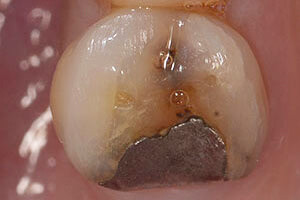
Failing Amalgam Filling
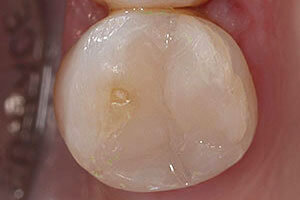
Composite Filling
Both types of fillings have been around for a number of years, although the metal “amalgam” material was adapted for dental use much earlier, about 150 years ago, while composite fillings gained significant popularity in the last 30+ years.
The official line – both materials are safe and effective, with amalgam material exhibiting greater strength, lower cost and easier handling during placement. On the other hand, composite mimics tooth structure in appearance, is more expensive and more difficult to place.
When I opened Smile Design Center in 2002, I decided not to use any amalgam material at all. The reasons were the following:
- composite material at that time exhibited sufficient strength and durability for front and back teeth;
- I didn’t like the look of the black fillings and neither did most of the patients from my previous office;
- I believed that bonded composite material reinforced tooth structure;
- I didn’t want to expose my staff and myself to mercury that is a part of the amalgam filling material;
- I was prepared to refer patients to other dentists who placed amalgam fillings.
After placing thousands of composite fillings, and observing them over the last 12 years and based on my private experience, I feel that the following is true:
- very few composite fillings had to be replaced due to recurrent decay and fractures, I estimate the number to be less than 5%;
- composite fillings did not show excessive wear;
- thorough moisture control must be implemented during composite filling placement if long life of restoration is to be expected;
- amalgam fillings are good alternative for smaller cavities if patient doesn’t mind black color of the filling material and can’t afford extra cost of composite;
- large amalgam fillings can create fracture lines that can lead to loss of teeth.
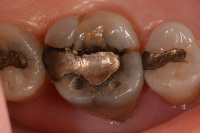
Picture 1.
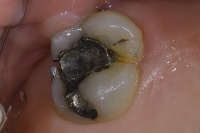
Picture 2.
Pictures 1 and 2 are of amalgam fillings that caused catastrophic fractures of teeth. I had to remove these teeth and many others because the fractures went through the entire tooth. Dental implants were placed after extractions. Picture 3 shows fine crack lines inside the tooth after removal of amalgam filling. Picture 4 shows composite filling after 12 years in function.
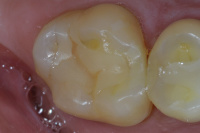
Picture 4.
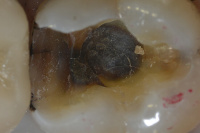
Picture 3.
Picture 3 shows fine crack lines inside the tooth after removal of amalgam filling. Picture 4 shows composite filling after 12 years in function.
If you are having issues with existing fillings or want to hear more about dental implants – Dr. Bondar and the Smile Design team are hear to help.
Call us at 1-603-427-0043

